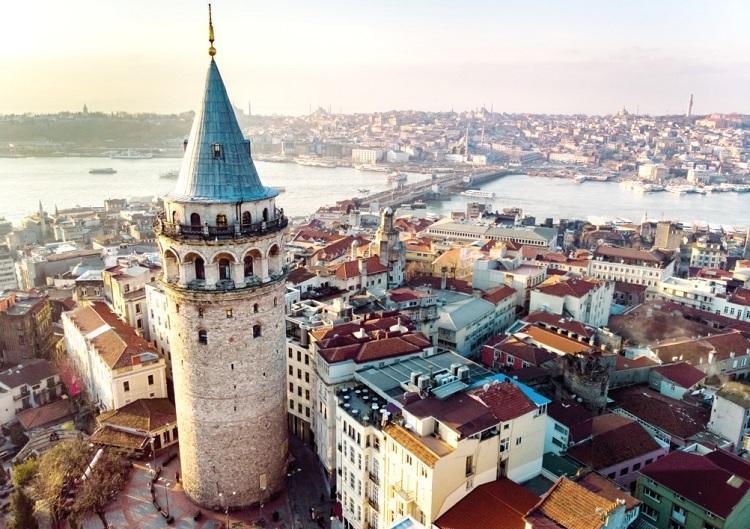
Towards the end of the first era, there was a small settlement area called Sykai / Sycae, İncirlik, in the north of the Golden Horn. In his work titled “Anaplous Bosporou,” Dionysios Byzantios wrote in 197 A.D. that there is a very suitable place for fishing in the present-day Galata region during the winter months and this place is called “Bolos,” which means a place for nets.
He tells that there is Artemis Phosphoros (Luminous Artemis) and Aphrodite Praeia (Peaceful Aphrodite) temenos near Bolos. Temenos is the name given to the sacred areas surrounded by a wall called peribolos, where temples are located in ancient architecture. Apparently, the first core of Galata is this sacred area.
During the administrative arrangements made after the city was declared as the new capital of Rome by Constantinople I (324-337) on May 11, 330, it was included in the city borders as a region. Known as Sykai or Regio Sycaena during the reign of Justinian (527-565), this settlement was enriched with new buildings. For this reason, it is called Justinianopolis for a period.
There have been serious discussions about the etymology of the name Galata for a long time. Some sources claim that the Galatians settled here in the early periods and that the name Galata was given for this reason. Despite all opinions, the name Galata is still not an agreed issue.
In 668-669, during the Umayyad period, the Islamic armies were first seen in front of Constantinople and made a two-year siege. Towards the end of Muawiya’s reign in 673, a second siege, lasting seven years, took place. These sieges, unlike the others, were carried out for the first time by forces from the sea with a strong fleet. This new initiative, which seriously threatened Constantinople, revealed the need for the city to take new measures. It was decided to build two fortresses, one near Sarayburnu and the other at a point of Galata settlement towards Tophane. A small fort, known as “Kastellion ton Galatou,” was built in the Galata region.
In the 12th century, the Genoese, who had a concession zone in the city (Istanbul) on the shores of the Golden Horn, were obliged to leave their concession areas to the Venetians after the Crusader Army took the city in 1204. During the Latin defeat in 1261, with the Treaty of Nymphaeum on March 13, 1261, a concession zone was given to the Genoese again in the city and they were allowed to settle in Galata. Since there was no fortification wall to protect the settlement, Galata settlement was burned and destroyed to a great extent during a Venetian attack on July 23, 1296.
The section, where today’s Galata Tower is located, was added to the walls built earlier in 1349, and a tower was built in the meantime. Taking advantage of the gradual weakening of the Byzantine state, the Genoese strengthened the walls around their settlements in time, and they dug a 15-meter-wide ditch in front of the sections between Azapkapı, Şişhane, Galata Tower and Tophane.
It is claimed that the tower was raised to a point close to its current length during the period of Podesta Baldassare Maruffo in 1445-1446.
One of most important symbols of city
Contrary to what is often stated, Galata Tower is not a 1,600-year-old building, but a Catholic monument, whose construction began in 1349, which the Genoese call the Tower of Christ as if they were making a show to the Orthodox population. It has been one of the symbols of this city for a long time, a cultural asset inherited to our country centuries ago.
It is said that the Ottoman Sultan Mehmed II, known as Mehmed the Conqueror, had the two floors of the tower demolished up to 7.58 meters. Later, during the reign of Sultan Bayezid II (1481-1512) in 1509, a great earthquake took place, which is described as the Little Apocalypse in our history, and the tower was greatly damaged.
The tower was used as a dungeon during the reign of Sultan Süleyman the Magnificent (1520-1566). It is known that the tower, which was destroyed by various fires in the period of Sultan Selim (1566-1574), underwent a major repair.
Since the facades of military buildings such as castles, bastions, fortresses, and ramparts were not covered with plaster in the past, they are regularly painted with lime whitewash every year.
Watchers were placed in the tower to observe and inform the fires that were frequent and caused great damage in 1717 in Istanbul. On the other hand, in a fire that occurred on July 25, 1794, the lead-covered wooden roof of the tower burned along with the stairs.
Sultan Selim III (1789-1807), regarded as the enlightened ruler of the time, immediately demolished the damaged section of approximately 190 centimeters from the top, which was built in a wooden pinnacle and a lead cone similar to the present day.
Until 1962-1963, the tower, which was used for different services, especially as a fire news center, was life-threatening due to the decay and deterioration of the roof construction and wooden flooring. Finally, it was emptied and its restoration started in order to be allocated to touristic services. The restoration took two years and the tower was opened to service in 1967. The facade that has not been maintained for 30 years was repaired in 1997 by the Istanbul Metropolitan Municipality.
Galata Tower, whose ownership has been transferred to the General Directorate of Foundations since it was a foundation property in the past, is recently undergoing a major repair after a long time. Restaurant and cafe sections built during previous restorations are closed. From now on, the Galata Tower will continue to exist as a viewing venue and a museum promoting Istanbul’s cultural values.